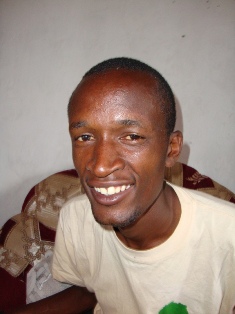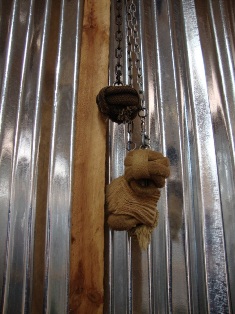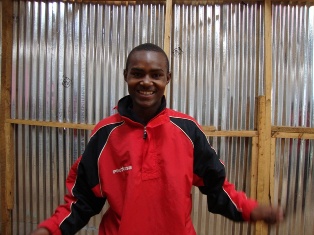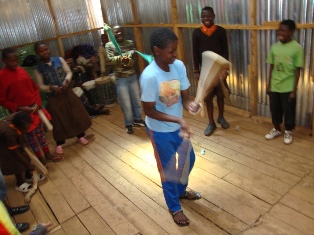The great Kenya adventure, Part 2
Sat, 08/07/2010 - 1:45pm by Drex Tags:
Every teacher knows their job is not just as simple as telling their students what to do and leaving it at that (or at least, all good teachers do). On one level you have to keep those students who are zipping ahead of the class engaged while making sure that those who just aren't getting it don't get left too far behind. There's a modicum of encouragement delivered at the right time or a look of skepticism for those who are cutting corners, as if to say "is that REALLY the best you can give me?" Teaching poi presents these same challenges and then some as you help students work up their coordination with an object that ultimately is alien to the way their body normally moves. One of the first hurdles to learning poi is to realize that poi can be moving in the same direction even if it looks like it has switched to you.
 Most of the kids in Kibera and Sarakasi speak English, which is helpful, but it tends to be filtered through British slang and terminology and a Kiswahili accent--I frequently have to ask people to repeat themselves to fully understand them. I can't even imagine how incomprehensible I must be with my thick American accent, tinged both with a Coloradoan drawl and the occasional invasion of a Youper "aboot." Fortunately, the language of poi and movement is universal. And the excited look on a child's face when they've finally nailed a trick they spent a half an hour on is the same the world over.
Most of the kids in Kibera and Sarakasi speak English, which is helpful, but it tends to be filtered through British slang and terminology and a Kiswahili accent--I frequently have to ask people to repeat themselves to fully understand them. I can't even imagine how incomprehensible I must be with my thick American accent, tinged both with a Coloradoan drawl and the occasional invasion of a Youper "aboot." Fortunately, the language of poi and movement is universal. And the excited look on a child's face when they've finally nailed a trick they spent a half an hour on is the same the world over.
 The poi the children use are simple sock poi sets with bags of sand in the ends. So far there has been only one casualty--a bag of sand that blew up last week. The poi all stay onsite both to ensure they'll be available to practice with and because they're less likely to get ruined if they leave the room. An occasional set of fire poi hangs on the wall--these are jerry-rigged sets made from a strong local welded steel chain and lengths of kevlar rope too short to make monkeyfists instead tied into improvised knots.
The poi the children use are simple sock poi sets with bags of sand in the ends. So far there has been only one casualty--a bag of sand that blew up last week. The poi all stay onsite both to ensure they'll be available to practice with and because they're less likely to get ruined if they leave the room. An occasional set of fire poi hangs on the wall--these are jerry-rigged sets made from a strong local welded steel chain and lengths of kevlar rope too short to make monkeyfists instead tied into improvised knots.
Class usually begins with arm and poi plane warmups, getting the four combinations of timing and direction into muscle memory for the kids before having them perform globes/orbs to give the kids the plane control they'll need for the more advanced tricks we will play with. From there we reinforce the concepts we've been drilling since I got there, using stalls to switch from thread-the-needle to weaves and planting the seed of the idea that waistwraps and butterflies are in the same plane, not weaves and butterflies. Some of the students will half-heartedly hide an eyeroll as they wonder when we get to the good stuff, but I hope they'll continue doing these exercises after I'm gone and fully explore the difference between the plane sets. Then we introduce new concepts and the challenge really starts.

Many of the students like to view a trick and then work through it themselves till they get it. "Drex!" they'll call in a few minutes, "look here!" Others look up at me with skepticism and give it a few good-natured tries. For them there are a variety of options: there are some corners I can show them how to cut either by thinking of a trick in a different way or by focusing on a single aspect of the movement that is errant in their current attempt. For students who just aren't getting it, there is one additional option available here that is not available in the United States: actually guiding the students through the motions by standing behind them, holding their hands, and performing the trick for them with their own hands. In many cases, this is the most difficult option for me given that I frequently tower more than two feet over the students (strangely I'm finding here that, like the states, I'm almost always the tallest person in the room), but it's also something of a "nuclear option" when I just can't get the subtlety of a move across. Doing this has worked more times than I can count and leaves me wishing we weren't so taboo about personal contact in the states--it would make beginner poi much easier.
 Teaching a move, then, requires bouncing back and forth between demonstrating for the full class and the individual attention necessary to catch as many students up as possible. The class ranges from 15-30 students with my contact at the school, Adoli, occasionally jumping to assist. One of the older boys, Cyrus, frequently plays the older brother by jumping in to help out the younger students. Once the internal blocks have been cleared, there is a look of suspense upon the child's face as they wait for approval for the new move. The harder they work, the greater the relief when the move comes. Smiles are inevitable and frequently the students give me a fist bump to celebrate, called "gota" here. I call out "wei wei!" to celebrate, approximating "look at you!" Some standouts in class, including Cyrus, a young woman named Jacky (not Will's wife), Amos, Rosalind, and many others now have frequent cycles of frustration, concentration, and finally catharsis with poi. With any luck, the lessons learned from studying poi will come to apply to other parts of their life as well as I know they have with mine.
Teaching a move, then, requires bouncing back and forth between demonstrating for the full class and the individual attention necessary to catch as many students up as possible. The class ranges from 15-30 students with my contact at the school, Adoli, occasionally jumping to assist. One of the older boys, Cyrus, frequently plays the older brother by jumping in to help out the younger students. Once the internal blocks have been cleared, there is a look of suspense upon the child's face as they wait for approval for the new move. The harder they work, the greater the relief when the move comes. Smiles are inevitable and frequently the students give me a fist bump to celebrate, called "gota" here. I call out "wei wei!" to celebrate, approximating "look at you!" Some standouts in class, including Cyrus, a young woman named Jacky (not Will's wife), Amos, Rosalind, and many others now have frequent cycles of frustration, concentration, and finally catharsis with poi. With any luck, the lessons learned from studying poi will come to apply to other parts of their life as well as I know they have with mine.
Thumps and oofs fill the air as we work through the moves, along with a constellation of exotic words like crossers, flowers, wraps, and meltdowns. The Kiswahili words for forward (mbele) and reverse (numa) are now permanent and irreversible parts of my vocabulary along with "pole" (pronounced "pole-ay," a statement of sympathy when someone hits themselves--the closest equivalent in English would be something akin to, "Oh, that sucks! I'm sorry!"). Much of the detail I give on specific moves gets lost, I'm sure, as my thinking on poi movement is so overwhelmingly colored by tech poi theory. Nonetheless, we find a common ground in the small victories of the tricks coming together. When it comes to antispin flowers, I say with some relish, "if it feels comfortable, your hand should be moving the other direction."
Next we work on choreography. Much of the acrobatics and dance the students learn when other teachers visit gets channeled into performances that happen when foreign visitors arrive or at festivals. As much as I love to go overboard on poi theory and tricks, it is in these performances that the students get to really apply all the lessons of the day--chaining them together to see how flow works and more importantly to have something to show their community when all is said and done. I have some apprehension about getting them ready to perform on fire, but the Kiswahili word for fire, "motomoto" makes ears perk up and eyes zero in like lasers whenever it is spoken. It is the fire that draws these kids in. We currently have two pieces we are working on--one that can fit any number of students and one based upon a part of my conclave's choreo from last year that is only for five dancers. It is here that the kids really shine, locking together and shifting seamlessly from one set of moves to another.
"Do you guys want to try it again or let it be for the day?" I ask the students after several frustrating takes of a particular peace, fearing the students may be near the end of their focus.
"Do it again!" shouts Jacky with a beaming smile. The others node eagerly. I can't help but smile--they're as much perfectionists as I am.
 When practice finally winds down, we bring out the drums that normally lay hibernating in the corner and the students take turns pounding out polyrhythms on them. We circle up and create unique spin jam where students jump in to show off a couple particular moves to the fanfare of their peers before backing into the circle and letting the next star take the stage. Some whip through lightning-fast weaves while the circle shrieks in delight while others take this as an opportunity to show off their mastery of the day's moves. They psyche each other up, sometimes literally pushing bashful students into the middle. Even if it's just a couple moves, they'll soak up the energy of the circle and cheer loudly for their peers. Everyone gets a chance and some ambitious comers push their way in multiple times to demonstrate their diversity in technique.
When practice finally winds down, we bring out the drums that normally lay hibernating in the corner and the students take turns pounding out polyrhythms on them. We circle up and create unique spin jam where students jump in to show off a couple particular moves to the fanfare of their peers before backing into the circle and letting the next star take the stage. Some whip through lightning-fast weaves while the circle shrieks in delight while others take this as an opportunity to show off their mastery of the day's moves. They psyche each other up, sometimes literally pushing bashful students into the middle. Even if it's just a couple moves, they'll soak up the energy of the circle and cheer loudly for their peers. Everyone gets a chance and some ambitious comers push their way in multiple times to demonstrate their diversity in technique.
We draw to a close with a fun gesture I believe I learned from Alien Jon: standing in a circle touching the tips of the fingers on our right hands together. We each curl our hands, effectively cupping each other's hands in a yin-yang like spiral before pulling our hands back out with a shout of triumph. I give some farewell gotas and high-fives to students as I pack up my daypack and Adoli leads me back through the labyrinth of Kibera back home.
"See you tomorrow!" I shout.
"See you tomorrow!" they shout back.
»
